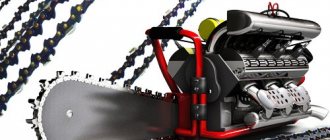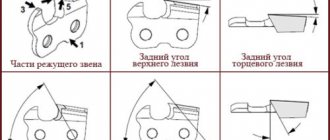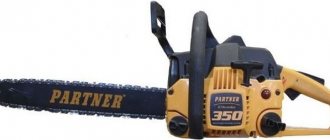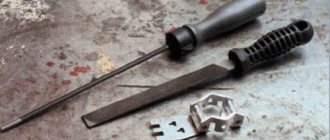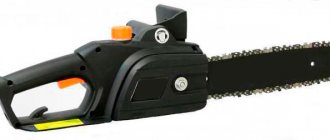How long does a regular hacksaw or two-handed “friendship” saw last without setting the teeth? For some, for years, for others, six months after purchase - “at least throw it away.” About the same thing happens with a chain for an electric saw. If with a hand tool everything is clear, since even with a completely chipped tooth the saw can be reanimated, then with an electric saw this problem does not work: the speed of work and the force applied to the cutting site are much higher. Because of one eaten tooth in one or two approaches to the tool, the entire chain fails.
The saw chain is the most loaded element of the electric saw, so the design provides for the possibility of replacing it. The ideal option is to purchase a product from the same manufacturer and the same dimensions, including the pitch of the teeth and their sharpening angle, that is, a complete analogue of the “native” one, but sometimes this problem cannot be solved: you need to work now, but the search may drag on for a month. You have to make a choice from what is available in the nearest market, or place an order via the Internet.
When should the work be done?
When using a chainsaw intensively, sharpening is carried out quite often, often several times in one day. Particular attention should be paid to the fact that the contact of the chain with the ground significantly speeds up the process. Therefore, chainsaws must be used in such a way as to eliminate the possibility of contact between the chain and the ground. After several contacts, the chips will be very small, and the chain will go deeper into the material slightly. When considering this issue, it can be noted: the more often you have to sharpen the chainsaw chain, the less metal layer is removed. Also, if you sharpen frequently, the service life of the cutting element of the chainsaw will increase significantly. The main condition can be called the correct execution of the work, if you do it yourself. The procedure can only be performed correctly if you have a special machine. A sign that the cutting element of a hand chainsaw has become dull is a significant feed force. Properly sharpened chains determine a significant reduction in the feed force, that is, the chainsaws enter easily with a little pressure. Another sign of the need to sharpen chains is the production of very small chips. Sharpening a chainsaw when the signs in question appear is mandatory. Sharpening of chains is carried out in order to greatly reduce the tension in the body, reduce the cyclic load rate and fuel consumption. Also, if you do not sharpen the teeth of the chains on time, there is a possibility of increased wear of all components, as a result of which the service life of the hand chainsaw is reduced.
Replacing the saw chain yourself
Companies that produce electric saws do not prohibit replacing the chain yourself; on the contrary, they often include new products with instructions for repairing and replacing individual parts. You should start by purchasing a new chain.
We check the chain for compliance, that is, we study its characteristics: length (depending on the tire), pitch size (relative to the sprockets), thickness of the drive link
One of the common designs of budget saws is with side tension. To change the chain, perform the following steps in turn:
- move the protective shield while releasing the brake;
- use a screwdriver to turn the control tension screw, unscrew the nut, thereby loosening the tension;
- remove the cover;
- separate the bar and chain from the sprocket;
- remove the old chain from the tire and install a new one in its place;
- We perform the steps in reverse order.
We tighten the chain smoothly, without jerking. We finally tighten it after closing the plastic cover using a screw and nut.
There are modern systems for keyless chain tensioning, but many mechanics prefer traditional side tensioning, which is somewhat problematic, but proven and reliable.
Modern models of electric saws have so-called wing nuts for efficient chain tension. Thanks to this element, the replacement process is faster - and this is important for large volumes of work. Having released the brake, unscrew the nut and remove the cover. Slightly moving the tire back, remove the old chain, put on a new one - first on the sprocket, then along the entire length. Then we put the sprocket in place and tighten the nut. We turn the tension wheel in the direction indicated on the body and finally tighten the “lamb”.
The last step is to check the chain tension. It should fit snugly against the tire when the brake is released, but rotate under manual pressure. For a more effective check, it is recommended to run the saw at low speeds
You can watch the video for more information about chain tensioning:
Recent Entries
Lilac perennials that are beautiful, compact and do not crowd out other plants Why when buying seedlings you should not take the sellers’ word for it and how to determine the age of the plant using 3 signs Tomato seedlings have turned purple or whitish: why the color has changed and how to save the plants
Geometry Features
In order to sharpen correctly with your own hands, even if you use a machine, you should know the geometry of the tooth. Its constituent elements include:
- Spatula.
- The main link.
- Depth limiter.
In this case, the tooth blade consists of the following elements:
- End blade.
- Top blade.
You need to sharpen correctly with your own hands, taking into account the fact that the end and top blades must be positioned correctly relative to each other to ensure the best cutting performance. The back of the tooth forms a certain angle of the upper blade. A similar angle is formed to cut the blades into the material. Sharpening with your own hands should also take into account the fact that the blade has a narrowing towards the back - this design feature forms the angle of the end blade. It is created to ensure lateral cutting of chips.
Chainsaw chain tooth
The sliding surface and the end part of the blade forms the rake angle. In this case, the angle has a fixed value; it varies from 60 to 85 degrees. If you sharpen the teeth with your own hands, it is worth considering that the upper blade is the main one, and the angle formed by it is the most important angle. To summarize, when considering the issue of geometry features, we note that the sharpening angle can vary depending on the conditions of use. The basic rule that should be followed when sharpening a tooth with your own hands is the following: the higher the angle, the greater the performance of the chainsaw, but reducing the value ensures smoother running of the blades, reduced vibration and increased service life. It is worth sharpening taking into account that the indicator should be in the range from 25 to 35 degrees. An exception is the version of the blade, which is intended for longitudinal cutting - many manufacturers of the chainsaw cutting element can withstand 10 degrees.
Saw design
To better understand what a chainsaw is and how it works, it is advisable to know how it works.
By the way, it would be more correct to call the cutting tool of a chainsaw a saw chain.
The first saw chains appeared at the beginning of the twentieth century. The designers did not begin to puzzle; they simply mounted teeth on the chain, which quickly lost their functionality. In appearance they resembled those that stand on hand hacksaws for wood. Sharpening such a chainsaw caused great difficulties. But repeated attempts to create the perfect saw chain were crowned with success only in 1947.
Chainsaw device
This chainsaw has links with an L-shaped cut. Modern chains are, in fact, the direct ancestors of this development.
If during work the cutting speed begins to decrease, the chainsaw in the hands of the master begins to “walk”, then most likely the saw chain has lost its operational properties, that is, it has become dull and measures must be taken to restore them.
Chain structure in a chainsaw
In fact, the circuit is quite simple.
One of its main elements are the teeth, which are located on both the left and right sides, and which alternate. They are connected to each other through other links, namely connecting ones. They are made directly from specialized steel material. In addition, the upper part of the steel is coated with a hard chrome coating, which significantly increases the service life of the chainsaw. Also important parts of the chain of this type of tool are:
- cutting link;
- side and top edges;
- depth shear limiter.
Now let's try to understand the issue regarding the reasons for the blunting of the chain itself. Why does this happen and what factors influence it? This issue is quite serious, since the productivity of the chainsaw itself depends primarily on the sharpness of the teeth on the chain. So, let's take everything in order.
feel strong vibrations from the tool while working , and notice that the tool moves slowly, then be sure that the chain on your device is dull. This is mainly caused by intensive and excessive use of the tool.
In addition, contact directly with the ground or with much harder wooden elements is important.
In addition, it is worth noting that working with such a chainsaw is highly undesirable, since this kind of negligence can lead to significant problems. Among which are not only significantly high fuel consumption and very slow cutting, but also vibrations directly on the body, and this, in turn, leads to breakage of the sprocket and even the tire itself.
Why does the tool become dull?
Each chainsaw has a certain durability period. This is the time from the start of work with a new tool until it becomes inoperable.
Destruction or wear of a cutting tool intended for woodworking occurs due to the impact of a set of forces arising during the cutting process. One of the key ones is friction force. Dulling of the saw chain occurs due to prolonged work, due to the use of a chainsaw for purposes other than its intended purpose.
The amount of wear can be defined as a measure of weight, measured in milligrams. Wear is a parameter that shows a change in the characteristics of the shape and size of the cutting blade. The change in geometric parameters that occurs during cutting, and there is no linear wear, is called blunting.
There are parameters on the basis of which a decision is made about the possibility of further operation of the tool. In particular, when examining the teeth of a saw chain, it is necessary to pay attention to the edges of the front and rear surfaces, the height of the blade, and the wear area. If they are in unsatisfactory condition, it means it’s time to sharpen the chainsaw.
Signs that the saw has lost its sharpness include the following:
- Reducing chip size.
- Using more force to do the job.
Chain selection
On non-professional chainsaws intended for household use, saw chains are usually installed with a pitch of 0.325 inches. The smaller the pitch of the saw chain, the less vibration it has, but with this the performance also decreases - this must be taken into account when purchasing in a store.
Chains intended for professional work are installed in 3/8 or 0.404 inch increments. With the use of such a chain, productivity increases significantly, but vibration also increases. Such chains are used for work in industrial logging sites.
For frozen and contaminated trees, saw chains with carbide tips are used.
The chain pitch is calculated by the distance between two nearby teeth or the length of the segment between two nearby rivets, divided by two. Component parts from chainsaws from different manufacturers cannot be combined.
The saw part of a chainsaw consists of a sprocket, a bar and a saw chain. Parts from different manufacturers in this kit are not compatible due to incompatible process parameters: drive link thickness and chain configuration. Therefore, you need to choose your chainsaw model very carefully and carefully. After all, after purchasing it, you will depend on the supply of spare parts kits from the manufacturer.
There is an opinion that the performance of a chainsaw depends on the shape of the chain, but this is an erroneous opinion.
In fact, performance directly depends on the power of the engine, since the more powerful the engine, the more torque is transmitted to the chain.
And the power of the engine determines how much more it has the ability to pull the chain through the material being cut. As a result, we can say that the most effective ratio for chainsaws with a powerful motor is a chain pitch of 3/8 inches.
When to sharpen and how to find out about it
After examining the saw chain, the master decides whether it is time to sharpen the tool or not.
As a rule, the saw chain loses its performance properties during intensive work. It can get to the point where the chain will have to be sharpened several times in one day. The cause may also be contact of the saw with the ground. In fact, just scrape the saw chain across the ground a few times and you can stop all work. The chainsaw will simply stop going into the tree. By the way, one of the signs of a dull saw is the appearance of small chips.
Dull chainsaw chain
The sooner measures are taken to sharpen the chain, the longer it will last. It is quite easy to understand when resharpening is required. There will be a feed change. A chain with properly sharpened teeth will retract even with a small force, but if during operation you have to exert a greater feeding force, then this means only one thing, the teeth have lost their sharpness.
Do not use a blunt chain. By the way, this is a safety requirement. And the process will require significant muscular effort from the lumberjack. As a result, this leads to a decrease in cut quality, an increase in the amount of fuel used and accelerated chain wear.
File
A file can be used to carry out the work in question. A file is used to remove the required layer of metal from the surface. A special set was created for this case:
- The file is round and has an unusual holder.
- Flat file needed to adjust the depth limit.
- Hook.
- Special template.
The round file holder is created along with marking lines that are used to position the tool correctly. During operation, the plate itself comes into contact with the depth stop and the surface of the blades, and the file moves around and removes a layer of metal. The use of a special holder with a file allows you to ensure the correct fit of the tools to the surface being processed. You should only use a file that is designed to perform such work.
Angles of inclination when sharpening with a file
The rules of work include:
- The same number of movements should be done.
- It is necessary to control the force of pressure on the surface during processing.
- The template, which is used together with the file, allows you to maintain important sharpening parameters.
With different lengths, uneven travel and the formation of cracks in the material are observed. If the length indicator is not the same at the start of processing, then all cutting teeth are filed according to the indicator of the smallest one.
How is a power saw chain lubricated?
To lubricate the saw blades, the design of any household electric saw provides a separate system, the basis of which is a pump. During operation, it creates the pressure necessary to pump oil from the reservoir into the grooves provided in the guide. From there, the oil enters individual grooves or holes located in the cutting teeth of the chain.
To prevent the cutting parts of the electric saw from running dry, you need to constantly monitor the volume of oil in the tank. If necessary, the operator must top up the amount of fluid used.
Pump failure causes typical problems. The most common of them is a situation in which the chain on the electric saw is not lubricated. In this case, the owner of the electric saw must immediately replace the pump, having first cleaned the place where it is installed in the garden tool.
Lubrication of the electric saw chain should only be done using specialized oil. Manufacturers of garden equipment prohibit the filling of transmission compounds and waste fluids. They quickly clog the lubrication system pump, which leads to its overheating and breakdown.
It is best to use specialized oils from Stihl, Husqvarna, Ravenol, Liqui Moly and Motul to lubricate the cutting headset of an electric saw. They are distinguished by high adhesion, biodegradability, and the ability to protect cutting organs from wear and corrosion. Oils of these brands work properly in wide temperature ranges and are not afraid of high air humidity.
Application of special machines
It is not always possible to use a hand tool with a template. For example, if the cutting edge comes into contact with the ground during operation, there is a possibility of its deformation. In this situation, a special machine is used. The machine comes in two types:
- Mechanical.
- Electric.
The power saw has a design that looks like a bow saw, but with a round file. The machine can be used to level the length of all edges and restore the correct geometry. The machine in question has a complex system for setting processing parameters. Sharpening is performed in approximately 2-3 movements, after which the machine is installed in a new location.
The electric machine is easy to use. A special adjustment system allows you to correctly position the surface to be treated, as well as position the disc with high accuracy. Some models have an automatic vice clamping system when the disk is lowered. The cost of the electric version is slightly higher, but at the same time the performance increases significantly and the most accurate result can be achieved.
PDF Guide to Sharpening Stihl Saw Chains
How to properly put a chain on a power saw?
To install a new cutting set, the user of a garden electric saw will need a screwdriver, gloves made of thick fabric, and a wrench.
To install the chain on the electric saw, you need to follow the following procedure:
- First, you need to unscrew the guide bar mounting nuts using a wrench. Before doing this, it is important to make sure that the inertia brake is in the off position. Otherwise, the operator risks breaking the tension cable of the inertial mechanism;
- Then you need to carefully move the brake pad to the side;
- Next, you need to move the guide bar, while trying to engage the drive sprocket of the electric saw. This is necessary in order to remove the part of the tire mounted on the sprocket. The rest of the guide - its shank, is attached in special holes;
- After this, you need to put the chain on the electric saw and adjust the tension of the cutting element, using a separate plastic tensioner for this;
- Then you will need to install the protective cover and unscrew the bolts securing it completely.
https://www.youtube.com/watch?v=grQnNG8cifE
Whenever installing a cutting tool, you need to pay attention to the level of its tension and the force that needs to be applied to manually rotate it along the tire. If necessary, the screws must be loosened or tightened, otherwise the cutting element will jam or constantly fly off the guide.
How to properly sharpen a chainsaw chain with your own hands. Step-by-step instruction
Bringing a chain into working condition has its own characteristics. They are determined by the configuration of the tooth. It includes two edges, located - one at the top and the other at the bottom. Moreover, the edge located towards the top has a slope at a given angle. In fact, the tooth, both in geometry and in its operating principle, is similar to the blade of a carpenter’s plane.
Manual chain sharpening diagram
For competent sharpening, the master must understand the structure of the tooth.
Teeth parameters
The tooth structure consists of:
- grounds;
- shoulder blades;
- limiter.
Two cutting edges are formed on the blade, one is placed on a horizontal plane, the other at an angle. To obtain the required parameters, the blades are sharpened at the angle specified in the technical specifications. The rake angle is sharpened in the range from 60 to 85 °.
The clearance angle indicates the backward tilt of the upper blade. It lies in the range of 50 to 60°. The blade located on top is considered the main one; the rear angle in this design is very important. It is difficult to measure; if the sharpening rules are followed and the geometric parameters are observed, it is formed in the specified range.
Teeth
The corners are sharpened depending on the use of the tool. The main rule is that the larger the angle, the greater the efficiency when processing soft wood; the smaller the angle, the easier it is to operate the saw with hard wood. That is, the smoothness of operation improves and the vibration of the tool decreases.
Meanwhile, the situation of sharpening the angle greater than 35 and less than 25° should be avoided. This rule does not apply to rip chains.
The angles change when editing the tool. They have an important impact on cutting parameters, so all technical requirements must be carefully followed.
Possible ways and methods of chain sharpening
Working with a file
The best solution is simple “bells and whistles” for sharpening work. This set includes a round and flat file, special holders, a gauge template, a hook for removing chips, etc. Structurally, the “devices” may differ, but the functionality has a common logic.
The diameter of the round file directly depends on the size of the chain:
- — Chains with ø 1.3 – require a file ø 4 mm (used much more often);
- — Chains with ø 1.6 – require a file ø 5.2 mm;
- — To sharpen the depth stop, use a flat file.
Sharpening process
- Having previously “turned on” the chain brake, firmly clamp the chainsaw bar in a vice (a tightly clamped saw is the key to successful sharpening)
- Position the template so that the “arrow” points toward the “nose” of the tire. Be sure to mark (you can use chalk) the tooth from which you started sharpening, otherwise you can go around the second round;
- Sharpen in the direction indicated by the arrows. Remember, each tooth of the chain has a special factory notch. It indicates the maximum sharpening angle.
- In addition to the cutting tooth, there are limiters on each link. They are sharpened as needed. This is necessary in the case when, as a result of sharpening, the height of the tooth decreases and problems arise in the operation of the chainsaw. As a rule, the limiter is sharpened after 2-3 sharpening of the teeth;
“If you don’t have sharpening skills, it’s better to start with inexpensive chains.”
Recommendations:
- The file should not extend beyond the top of the cutting edge, more than 1/5 of the working part of the file. The pressure is applied with the same force;
- The movement of the sharpening tool is performed in one direction “away from you”, and the number of movements for each tooth should be equal;
- To sharpen a vertical plane, the position of the file should be at a right angle;
- For sharpening on a horizontal plane, file position at an angle of 20-30°
- If there are teeth of different heights, the reference point is the smallest one.
Read also: Examples of polymers in everyday life
Advantages: Ability to “charge the saw” in the field. At the same time it’s cheap.
Disadvantages: Takes time and effort. At the same time, the file quickly “kills”. By the way, about files: it’s better to pay a little more and get a quality product than to buy it for 40-50 rubles and throw it away after the first sharpening (tested in practice). And also, if the chain has “plowed” the soil so well that its cutting edge has changed its original shape, sharpening with a file is difficult and not at all quick.
Sharpening with a grinder
Professionals consider this work to be primitive. There is a risk of tire damage, and not only that.
Process (looks easy, but is actually difficult)
- The chain also remains on the bar;
- We attach a cutting disc for metal with a thickness of 1.5-2 mm to the grinder. It is advisable to take something that is not new, that is, with a reworked edge;
- We put a barrier in front of the chain and tire (a sliver will come off);
- We sharpen at the desired angle;
- Upon completion of the work, the chain must be properly tightened.
With a professional approach and a “full hand”, the number of sharpenings in this case can be more than 7.
“For a beginner, it’s better not to “experiment” with a saw, chain, etc. with your body parts!”
Advantages of the method: Fast, cheap and does not take away strength;
Disadvantages: Requires special skills, a steady hand and the ability to follow safety precautions.
Electric sharpening machines
They are equipped with special adjustment functions that help position the chain at a certain angle. At the same time, it is possible to accurately and accurately bring the disc to the chain teeth. There are machines equipped with automatic vices. They turn on when the disc is brought to the edge being sharpened. Convenience and functionality are of course high. You can also find models at “increasing” prices.
Manually driven machines
The design of such a machine is similar to a bow saw. Only, where the saw blade is located, there is a round file. With this machine you can sharpen and straighten teeth, adjusting the proportionality of the upper edges to the smallest (control) size. The mechanism allows you to accurately set the parameters. After adjustment to the “control” tooth, sharpening is carried out in two or three movements. And then move on to the next tooth.
When it is necessary to sharpen the limiter, replace the round file with a flat one.
Advantages of the method: Allows you to sharpen teeth efficiently, conveniently and without great physical effort, including those that have lost their original shape.
Disadvantages: Price of the tool and distance from the possible area where the saw will be used.
What to choose for sharpening is up to you. This has to do with how often you use the chainsaw. From handling it carefully. From the quality of the purchased chain. And, of course, from the opportunity to spend a certain amount. It is impossible to compare methods, because as the German proverb says, “apples must be compared with apples.”
Tips and tricks on how to sharpen a chainsaw at home
It is permissible to use a file for sharpening, but you must understand that such operation of the saw will require certain skills and, of course, patience from the master. To sharpen each tooth, you need to have flat and round needle files on hand. To sharpen a tooth, without using additional equipment, it is necessary to maintain the basic sharpening inclination. Only 2-3 passes with a file are enough for sharpening, so there is no point in inventing some kind of equipment to fix the tooth in a certain position. To sharpen the top edge, the file must be held at the required angle while working. Restoring operability begins with preparation, namely, from the working edges; it is necessary to remove all nicks.
If everything is clear with the angles of the teeth with straight parts of the structure, then the edge located on the side and its working inclination cause certain difficulties. To straighten them, you need to use a round file or a small file. These tooth elements are sharpened at the required angle.
Sharpening on a machine
If sharpening work is carried out quite often, then it is necessary to use special equipment and technological equipment (templates). Using a template on a device of this type allows you to complete this work much faster. Such a device can be a wooden block of small size. This type of template should allow sharpening at two angles. Sharpening can be done using a small diameter grinding wheel or an emery belt that can be mounted in place of the belt drive.
Chainsaw chain sharpening machine
Sharpening a chainsaw chain with a machine
Machines of this type, masters, can be made independently, using the drive from a foot-operated sewing machine as the basis for the design. Using a belt drive and a template, it is possible to process one cutting edge and then another.
Dumb tips for sharpening a chain
- The chain can be sharpened with a triangular file
- The chain can be sharpened with a nail file
- The chain can be sharpened with a grinder
- Sharpen teeth at 90° or the other way
- Grind off the stops more than 1 mm from the height of the tooth (or grind off the nafik altogether)
- Sharpen a chain according to Feng Shui (I don’t know how, but I think there are already ways)
etc
Chainsaws
| Manufacturers | Stihl |
| Chains | Oregon • Stihl • Chain sharpening • Chain oil |
| Info | Gasoline-oil mixture • How to choose a chainsaw • How to work with a chainsaw • Working off • Caring for a chainsaw |
| How-Know | Chainsaw for women • Chainsaw chainsaw • Chinese chainsaw (Husqvarna / Shtil) • Four-stroke chainsaw |
| Chainsaws |
| Chains for chainsaws of any configuration produced by Stihl (Switzerland) in Moscow, you can find out about the availability and price of goods by calling +7 To support the site, call it when calling or purchasing goods |
Technical features of the sharpening process
The sharpening operation is complicated by the fact that the teeth have a large number of cutting edges located in different planes and having different sharpening angles. When sharpening teeth, it is necessary to make the same amount of movement, and it is necessary to withstand the same pressure force. As a result, all teeth will receive the same type of sharpening.
Also, if the saw chain is sharpened more than 4 or 5 times, then the depth stop must be reduced.

